
Authentication is the act of proving an assertion, such as the identity of a computer system user. In contrast with identification, the act of indicating a person or thing's identity, authentication is the process of verifying that identity. It might involve validating personal identity documents, verifying the authenticity of a website with a digital certificate, determining the age of an artifact by carbon dating, or ensuring that a product or document is not counterfeit.

Anthony Keith Gwynn Sr., nicknamed "Mr. Padre", was an American professional baseball right fielder, who played 20 seasons (1982–2001) in Major League Baseball (MLB) for the San Diego Padres. The left-handed hitting Gwynn won eight batting titles in his career, tied for the most in National League (NL) history. He is one of the best and most consistent hitters in baseball history. Gwynn had a .338 career batting average, never hitting below .309 in any full season. He was a 15-time All-Star, recognized for his skills both on offense and defense with seven Silver Slugger Awards and five Gold Glove Awards. Gwynn was the rare player in his era that stayed with a single team his entire career, and he played in the only two World Series appearances in San Diego's franchise history. He was inducted into the Baseball Hall of Fame in 2007, his first year of eligibility.
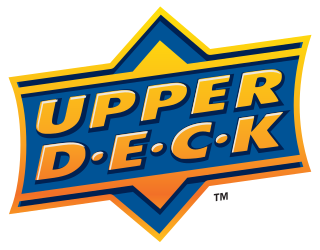
The Upper Deck Company, LLC, founded in 1988, is a private company primarily known for producing trading cards. Its headquarters are in Carlsbad, California, United States.
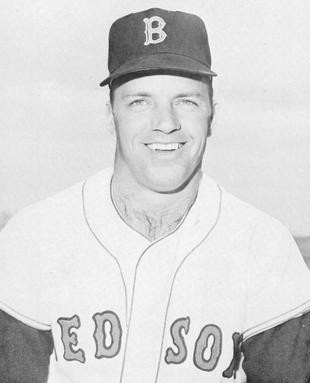
James Leroy Thomas was an American first baseman and right fielder, coach and front-office executive in Major League Baseball (MLB) who played for six teams from 1961 to 1968, most notably the Los Angeles Angels, then went on to a successful tenure as general manager of the Philadelphia Phillies. Traded to the Angels one month after the expansion franchise began play in 1961, he tied for third in Rookie of the Year voting after batting .285 with 24 home runs and 70 runs batted in (RBI), primarily playing in the outfield. The following year, he was named to the American League (AL) All-Star team after shifting to first base, and appeared in both All-Star games played that year as a pinch hitter and late-inning defensive replacement. He finished the year with career highs in batting (.290), home runs (26) and RBI (104), but a sharp decline in 1963 led to his being traded to the Boston Red Sox in mid-1964, the first of four trades before the 1968 season.

Ricardo Bones is a Puerto Rican former professional baseball pitcher and bullpen coach for the Washington Nationals of Major League Baseball (MLB). He played from 1991 to 2001 for three National League teams – the San Diego Padres, Cincinnati Reds, and Florida Marlins – and four American League teams – the Milwaukee Brewers, Kansas City Royals, New York Yankees, and Baltimore Orioles.

Dustin Eli Whiteside is an American former professional baseball catcher who is currently a roving catching instructor for the San Francisco Giants. He stands 6 feet 2 inches (1.88 m) tall, weighs 220 pounds (100 kg). He batted and threw right-handed. He played in Major League Baseball (MLB) for the Baltimore Orioles, San Francisco Giants, and Chicago Cubs.

The St. Louis Cardinals Hall of Fame Museum is a team hall of fame located in downtown St. Louis, Missouri, representing the history, players and personnel of the professional baseball franchise St. Louis Cardinals of Major League Baseball (MLB). It is housed within Ballpark Village, a mixed-use development and adjunct of Busch Stadium, the home stadium of the Cardinals. To date, 53 members have been enshrined within the Cardinals Hall of Fame.
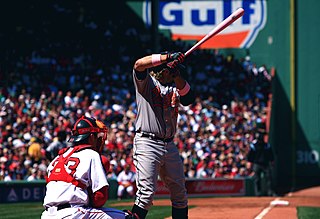
In baseball, pink bats are limited-supply baseball bats manufactured by Louisville Slugger for use by select Major League Baseball players on Mother's Day, first introduced in 2006 in association with the Susan G. Komen for the Cure organization. Each year on Mother's Day, Major League Baseball authorizes the use of the specially dyed bats — temporarily suspending the regulation that restricts players to using black, brown, red, or white bats — as part of a weeklong program to benefit the Susan G. Komen for the Cure organization.
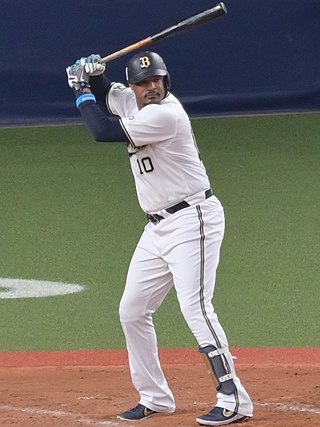
Adam LaMarque Jones is an American former professional baseball outfielder. He played in Major League Baseball (MLB) for the Seattle Mariners, Baltimore Orioles and Arizona Diamondbacks and in Nippon Professional Baseball (NPB) for the Orix Buffaloes.

Christopher Lyn Davis, nicknamed "Crush Davis", is an American former professional baseball first baseman. He played in Major League Baseball (MLB) for the Texas Rangers and Baltimore Orioles. He bats left-handed and throws right-handed. While primarily a first baseman throughout his career, Davis has also been a designated hitter, third baseman, and outfielder.

In baseball, batting average (BA) is determined by dividing a player's hits by their total at-bats. It is usually rounded to three decimal places and read without the decimal: A player with a batting average of .300 is "batting three-hundred". If necessary to break ties, batting averages could be taken beyond the .001 measurement. In this context, .001 is considered a "point", such that a .235 batter is 5 points higher than a .230 batter.

Dylan Matthew Bundy is an American professional baseball pitcher who is a free agent. He has played in Major League Baseball (MLB) for the Baltimore Orioles, Los Angeles Angels and Minnesota Twins.

The New York Yankees Museum is a sports museum located at Yankee Stadium on the main level at Gate 6. It is sponsored and presented by Bank of America and is dedicated to baseball memorabilia for the New York Yankees. It is a key attraction at the stadium, which opened in 2009.
John Olson is a forger associated with the FBI's Operation Bullpen investigation. He pled guilty to forging thousands of Muhammad Ali and various other autographs. The FBI gathered information on the ring during a previous sting known as operation FOUL BALL. They launched the investigation that would ultimately culminate with a bust on October 13, 1999. They took down the biggest forgery ring in sports memorabilia history. Chuck Wepner, a former opponent of Ali and tough man boxer from Bayonne, New Jersey, would vouch for the autographs and John Olson and others would sign the items.

Jorge Yabiel López Ramos is a Puerto Rican professional baseball pitcher for the Miami Marlins of Major League Baseball (MLB). He has previously played in MLB for the Milwaukee Brewers, Kansas City Royals, Baltimore Orioles and Minnesota Twins. He made his MLB debut in 2015 and was an All-Star in 2022.

Tanner Alexander Scott is an American professional baseball pitcher for the Miami Marlins of Major League Baseball (MLB). He made his MLB debut with the Baltimore Orioles in 2017.

Colton Dale Cowser is an American professional baseball outfielder for the Baltimore Orioles of Major League Baseball (MLB). He played college baseball for the Sam Houston State Bearkats.
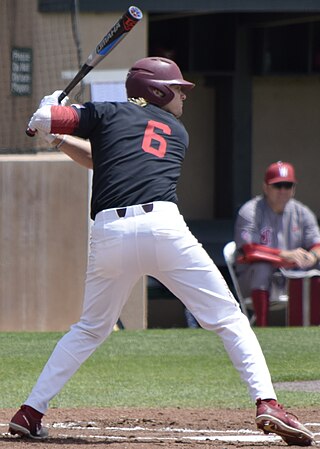
Kyle Jacob Stowers is an American professional baseball outfielder for the Baltimore Orioles of Major League Baseball (MLB). He made his MLB debut in 2022.
The 2023 Baltimore Orioles season is the 123rd season in Baltimore Orioles franchise history, the 70th in Baltimore, and the 32nd at Oriole Park at Camden Yards. The Orioles will look to improve on their 83–79 season from 2022, as well as make the playoffs for the first time since 2016.
Operation Bullpen was an FBI investigation into forged celebrity autographs and sports memorabilia that ran from 1999 until 2006. The investigation uncovered $100 million worth of fraud that occurred in the United States.

















